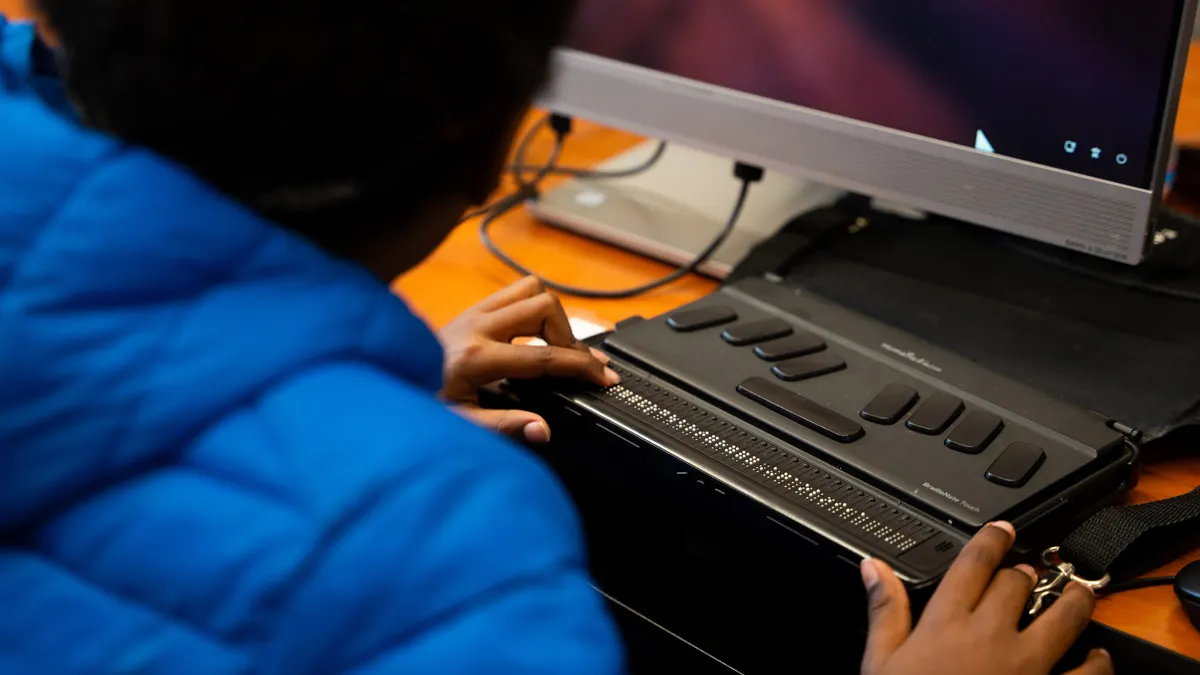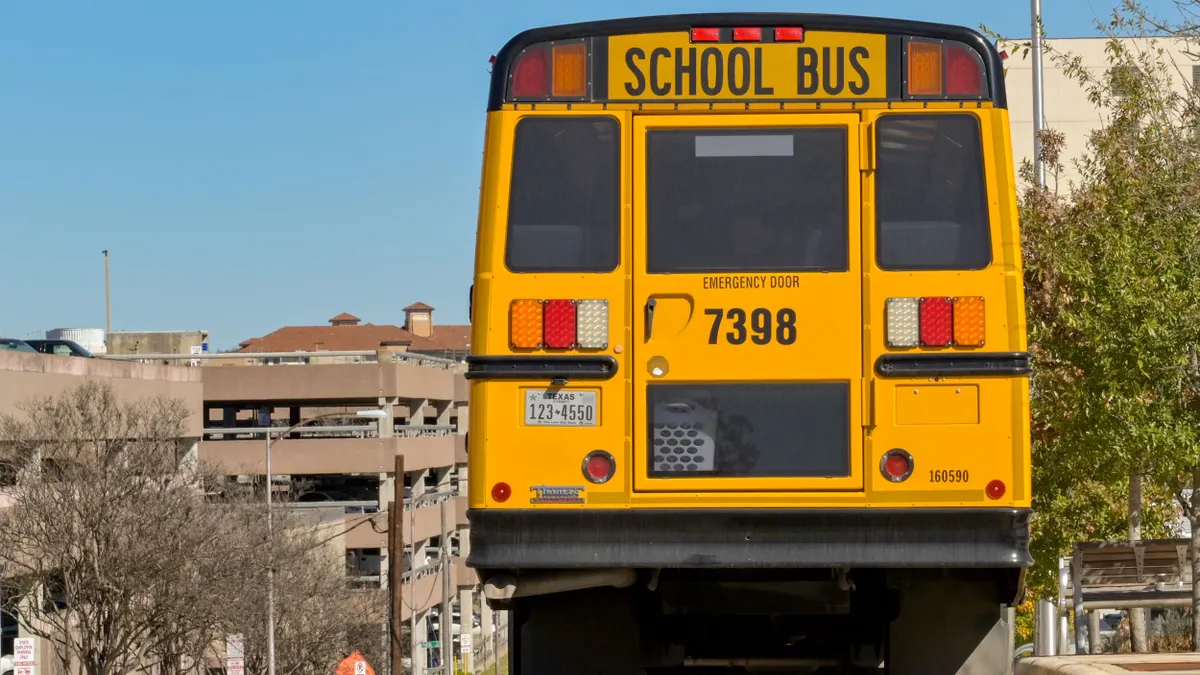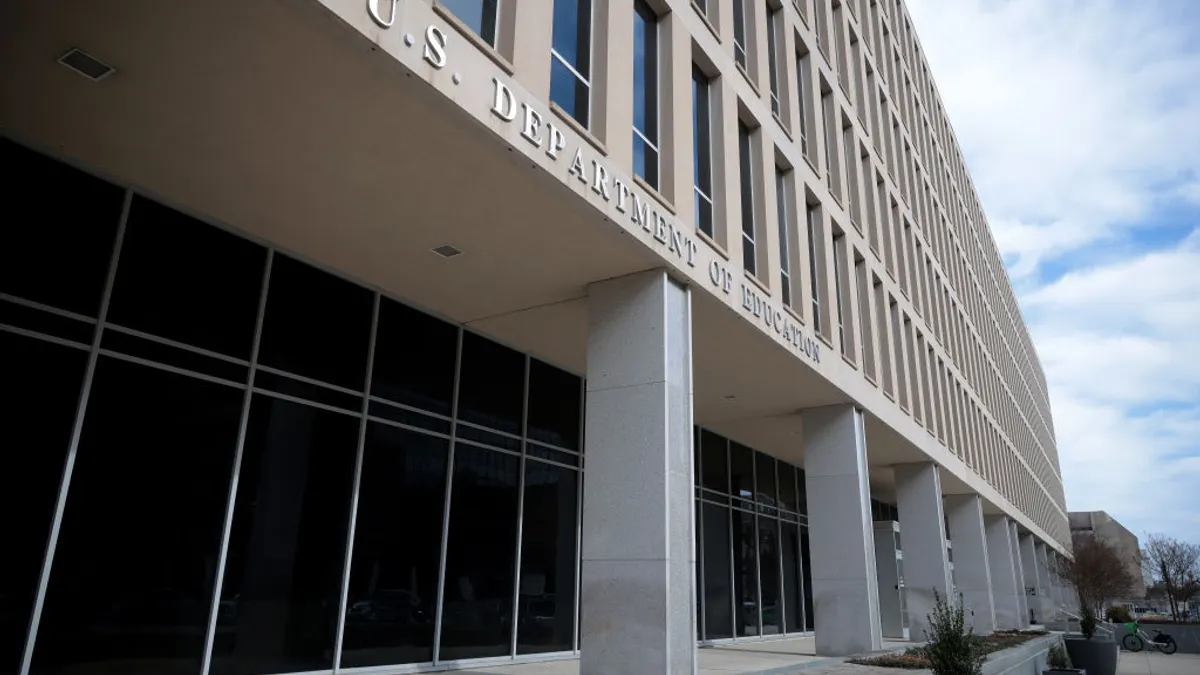Even as more than 400 U.S. Department of Education staffers received reduction-in-force notices on Friday, many of these laid-off employees remained in the dark about their employment status. That's because they couldn't access their work emails to view the RIF notices with the federal government shut down due to the congressional impasse over funding.
The RIFs impacted Education Department offices that oversee civil rights, special education, student achievement supports, budgeting services, school safety, postsecondary education and more, according to the American Federation of Government Employees, a union representing more than 2,700 Education Department employees, in an Oct. 12 email.
The situation follows months of downsizing at the agency, which began the year with about 4,133 employees and is now estimated to be at about 2,000 after Friday’s RIF. The Education Department, however, has not provided details about the layoffs.
Friday's mass layoffs have caused confusion, concern and anger among public school professionals and advocacy groups. They worry the Education Department will not be able to carry out its statutory requirements with such a lean staff, which would in turn impact districts, schools and families.
Some, however, say the agency needs to be trimmed and that less government red tape will give states and districts more freedom to budget based on their needs.Proponents of federal workforce downsizing laud the savings to taxpayers from reducing federal labor expenses.
Here we explain what you need to know about this situation.
What happened?
On Oct. 10, some 466 Education Department employees in various offices were to receive RIF notices, according to court documents filed by the White House's Office of Management and Budget. Across 30 federal agencies, including the Education Department, about 4,232 employees were expected to be laid off.
When the federal government shut down Oct. 1 because Congress could not agree on a budget for fiscal year 2026. The Education Department planned to furlough about 95% of its non-Federal Student Aid staff for the first week, according to a Sept. 28 memo from U.S. Education Secretary Linda McMahon.
During the shutdown, the Education Department expected to pause grantmaking activities, technical assistance support and Office for Civil Rights investigations. The ability of states and districts to draw down most federal grants would continue, as would the disbursement of student aid such as Pell Grants and Federal Direct Student loans, according to the memo. Student loan borrowers would still be required to make payments on their debt.
McMahon's memo also said the agency would continue to process the Free Application for Federal Student Aid.
During a federal shutdown, furloughed employees are typically forbidden to work, including checking their email. They also don't receive pay but in the past have received retroactive pay once the shutdown ends. According to an Oct. 7 article from the Associated Press, the Trump administration said it may not issue back pay once the shutdown concludes.
The Education Department’s staff had already been downsized this year due to large-scale layoffs in March as well as buyouts and early retirements. The Trump administration has further sought to eliminate the Education Department to the extent possible through program cuts and changes. These efforts have been challenged in court.
Some labor unions and education professional organizations are also questioning the legality of the latest layoffs. "These RIFs will double down on the harm to K-12 students, students with disabilities, first generation college students, low-income students, teachers, and local education boards, which are already feeling the impacts of a hamstrung Department from the March RIF," said AFGE Local 252 President Rachel Gittleman, in an Oct 12 statement.
The U.S. Office of Personnel Management's RIF policy says, "an agency is required to use the RIF procedures when an employee is faced with separation or downgrading for a reason such as reorganization, lack of work, shortage of funds, insufficient personnel ceiling, or the exercise of certain reemployment or restoration rights.”
OPM guidance issued late last month said agencies are allowed to issue RIF notices during a government shutdown and that employees may access their work computers to check the status of the shutdown or for RIF notices — but apparently some Education Department employees didn't see the guidance before the government closed.
What's the impact for K-12 schools?
Public school advocates are raising alarms about the extreme downsizing at the Education Department. While they don't expect an immediate impact on most day-to-day activities of schools, they warn that the reduced levels of federal support will become more evident at local levels the longer the shutdown lasts and if agency staffing levels remain low.
For instance, students with disabilities are still entitled to special education supports through individualized education programs as guaranteed under the Individuals with Disabilities Education Act. States and districts are still required to comply with IDEA. But with only a handful of people working on federal special education oversight, the accountability system is in jeopardy, advocates said.
"As we understand it, these RIFS affect all but a few staff and will harm students with disabilities," said Denise Marshall, CEO of the Council of Parent Attorneys and Advocates, in a Oct. 13 statement. "The action sends the message that our children are not valued and unfairly creates confusion and chaos in our schools."
Marshall added that "decimating the Department of Education disrespects and ignores the requirements" of IDEA.
In an Oct. 13 statement, AASA, The School Superintendents Association, expressed concern about the department's ability to oversee discretionary funding, formula grants and competitive grants.
The majority of staff in both the Office of Elementary and Secondary Education and the Office of Special Education Programs received RIF notices, and the two offices together are responsible for issuing about $44 billion annually, AASA said.
"There is reason to be concerned that ED cannot effectively manage this funding without many of these staff and there could be disruptions to district and state operations including reimbursement requests," AASA said.
A broad coalition of more than 350 national, state and local disability, civil rights and education organizations on Tuesday issued a statement condemning the Education Department firings, including those in the Office for Civil Rights.
The coalition also specifically mentioned oversight of IDEA, Section 504 of the Rehabilitation Act and Title IV of the Workforce Innovation and Opportunity Act.
"Without personnel to oversee these laws, the Department cannot provide essential leadership, oversight, guidance, or support to states and schools — jeopardizing students’ access to a free, appropriate public education and hampering the ability of states and localities to serve all students," the statement said.
The National Association of Federally Impacted Schools said most of the Impact Aid Program Office staff are believed to be among those affected by the latest layoffs. The Impact Aid Program supports districts that lose property tax revenue because of tax-exempt federal property within their boundaries.
"If true, the loss of the IAP program analysts — who process payments, provide technical assistance, and ensure the program runs accurately and transparently — would threaten the continuity and integrity of Impact Aid, with serious consequences for school districts, including those that serve large numbers of military-connected and Native American students," the group said in a Monday statement.
Washington State Superintendent Chris Reykdal said in a Monday statement that his office has not received any indication that federal funds are at risk for local school districts. The federal education grant system is active, and entities are still able to draw funds, he said.
And despite what's happening in Washington, D.C., Reykdal said Washington state is committed to the civil rights protections of more than 155,000 students with disabilities served under IDEA. School districts in the state rely on $275 million in federal IDEA funding annually, according to Reykdal.
Reykdal said Washington state has civil rights protections for students that go beyond the federal minimum protections, and the state Office of Superintendent of Public Instruction will continue to enforce those laws. He also said the state Legislature made significant bipartisan investments in special education in recent years.
Still, he said, without federal special education staff available to perform audits, provide technical assistance and complete investigations, the layoffs "remove several of the safeguards that the federal government has put in place, and the extent of the impacts to services for students and families is not yet known."
What's happening in the courts?
The American Federation of State, County and Municipal Employees, AFL-CIO, and other unions are seeking a temporary restraining order to reverse the RIFs across the federal government. A hearing on that request — which came in litigation originally filed against OMB on Sept. 30 in U.S. District Court in California — is scheduled for Wednesday.
Meanwhile, the U.S. Supreme Court has taken up several cases in recent months regarding the Trump administration's efforts to fire federal workers. The justices, in an emergency decision in New York v. McMahon, in July allowed the Education Department’s March 11 RIFs to take effect.
Lower courts are also addressing Education Department staffing reductions, including in a challenge to the firing of about half of the staff at OCR earlier this year.
Meanwhile, all eyes remain on Congress as to when the lawmakers may begin to seriously negotiate their way out of the spending impasse that is keeping the wheels of government from turning.







 Dive Awards
Dive Awards















